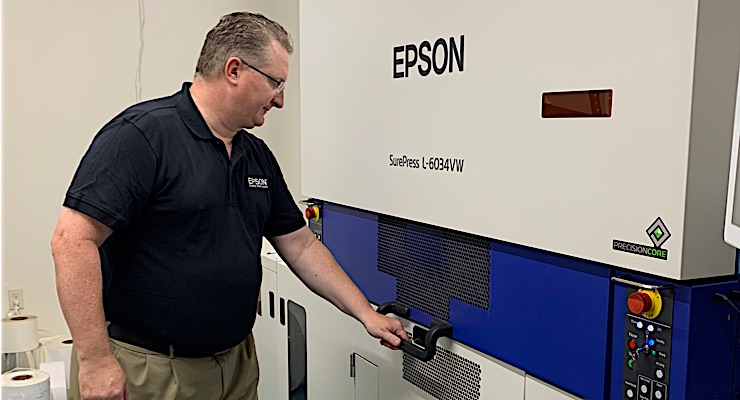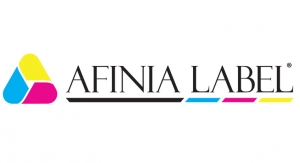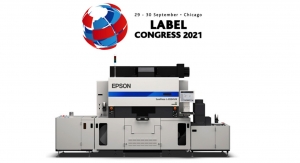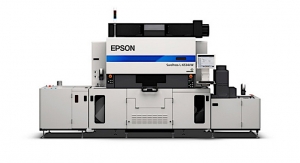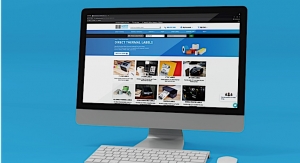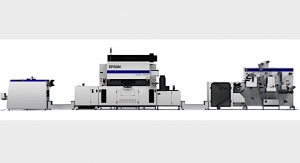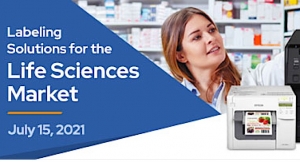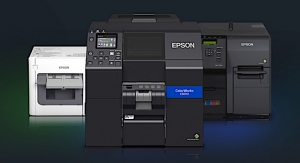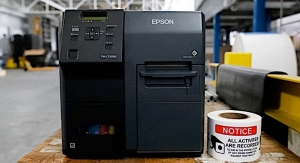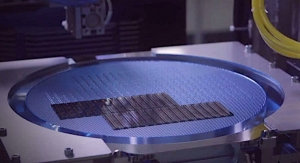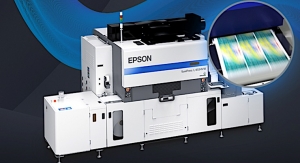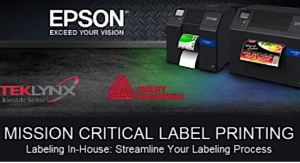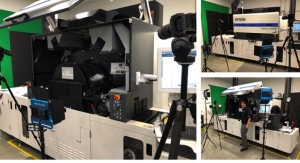Greg Hrinya, Editor09.01.20
As the calendar turned to 2020, Epson readied a new product portfolio for the labels and packaging marketplace. The digital printing specialist unveiled a host of new ColorWorks printers to complement its full scale SurePress line.
Since then, the North American label market has experienced highs and lows. The world continues to grapple with the COVID-19 pandemic. Many of the success stories are determined by end-use verticals. Supply chains have also been impacted to varying degrees.
“The overall state of the North American label market is surprisingly strong,” explains Victor Gomez, director of Industrial Label Products at Epson America Inc. “The large spike in demand that appeared in the second half of March and continued into April and May is now stabilizing, albeit at a higher level than before. The shift in demand, the suddenness of the changes and the broad reach of the pandemic’s effects have caused imbalances in matching supply to demand. There is excess capacity in some sectors and shortages in others.”
According to Gomez, labels for consumer staples and household chemicals have clearly been in much greater demand. Products meant to be consumed or used in public have suffered. Converters with a diversified portfolio of customers across verticals have been able to do very well redistributing capacity to meet the change in demand.
From a supplier standpoint, companies with an international reach have fared better. Epson also utilized its knowledge of the pandemic’s effects on the rest of the world before it reached North America – leaving the company better equipped to deal with the challenges.
“An adaptation in response to supply disruption – when missed deadlines can be costly or represent opportunities missed – has been to turn to trusted, reliable suppliers. Epson hasn’t had the same delivery issues as other suppliers because of the redundancy in our supply chain,” states Gomez. “For example, ink for our color label printers and presses is manufactured in any of half a dozen factories in different countries. The international nature of Epson’s business also means we saw the crisis build from its early stages last year, so we were prepared when it reached North America.”
The challenges presented by COVID-19 could spur the industry’s next wave of trends. During times of social distancing – and with fewer people working in the plants – the drive to automate will only increase. Automation will be utilized to streamline labor where applicable, and it will help alleviate the workforce challenge.
Multiple converters have told L&NW that they will not shy away from investments. In fact, they will be more inclined to grow their business, albeit with a watchful eye on the economy. Epson has noticed this same trend.
“With record low interest rates, and a high accelerated depreciation limit, the incentives to invest are compelling,” explains Gomez. “The companies that invest wisely in new equipment that are able to respond to the demands of the moment (faster turnaround times, shorter runs, automated, adaptable to shifts in demand) will do better than weather the storm – they will thrive.”
E-commerce represents another growth opportunity. “Consumers confined at home have turned to e-commerce for many purchases they would have made in person at malls, convenience stores or even supermarkets,” he adds. “The new trend has accelerated the move toward e-commerce dedicated packaging. Parcel logistics also presents brand owners with new vehicles for messaging. The shipping label itself, up to now a strictly utilitarian space served by monochrome thermal transfer, becomes prime territory for color, custom printed labels with an on-demand color inkjet device to include marketing or promotional content. Packaging tape on the corrugated box similarly offers branding opportunities.”
The potential financial difficulties facing some converters could necessitate a shift toward digital printing, too. Brands and converters will be driven by the same need to conserve cash by ordering only what is needed, when it’s needed, as close to the time and place of manufacture of their product.
“That affects the label business in significant ways because label inventories represent cash tied up in storage, cash lost in spoilage and at risk of obsolescence,” says Gomez. “So, label orders become smaller but more frequent. They are accompanied with expectations of ever shorter turnaround times. It’s no accident that the digital revolution in label production really gained steam in the aftermath of the financial crisis of 2008-09 and the recession that followed. The emergence of digital inkjet presses and printers, like Epson’s SurePress and ColorWorks lines, were a response to that business need. That same trend is in operation today: shorter print runs, faster turnaround times, in-house on-demand printing.”
While capital expenditures have been on hold in many segments of the market due to economic uncertainty, Gomez is optimistic about this resilient, essential industry.
“The North American label market will emerge from the current crisis stronger but not unaffected,” he says. “Nimbleness and sound financials will be rewarded. E-commerce will offer new opportunities for branding and promotion. End users and converters will be more attuned to, and make decisions based on, the reliability of their suppliers and the strength of their supply chain.”
Since then, the North American label market has experienced highs and lows. The world continues to grapple with the COVID-19 pandemic. Many of the success stories are determined by end-use verticals. Supply chains have also been impacted to varying degrees.
“The overall state of the North American label market is surprisingly strong,” explains Victor Gomez, director of Industrial Label Products at Epson America Inc. “The large spike in demand that appeared in the second half of March and continued into April and May is now stabilizing, albeit at a higher level than before. The shift in demand, the suddenness of the changes and the broad reach of the pandemic’s effects have caused imbalances in matching supply to demand. There is excess capacity in some sectors and shortages in others.”
According to Gomez, labels for consumer staples and household chemicals have clearly been in much greater demand. Products meant to be consumed or used in public have suffered. Converters with a diversified portfolio of customers across verticals have been able to do very well redistributing capacity to meet the change in demand.
From a supplier standpoint, companies with an international reach have fared better. Epson also utilized its knowledge of the pandemic’s effects on the rest of the world before it reached North America – leaving the company better equipped to deal with the challenges.
“An adaptation in response to supply disruption – when missed deadlines can be costly or represent opportunities missed – has been to turn to trusted, reliable suppliers. Epson hasn’t had the same delivery issues as other suppliers because of the redundancy in our supply chain,” states Gomez. “For example, ink for our color label printers and presses is manufactured in any of half a dozen factories in different countries. The international nature of Epson’s business also means we saw the crisis build from its early stages last year, so we were prepared when it reached North America.”
The challenges presented by COVID-19 could spur the industry’s next wave of trends. During times of social distancing – and with fewer people working in the plants – the drive to automate will only increase. Automation will be utilized to streamline labor where applicable, and it will help alleviate the workforce challenge.
Multiple converters have told L&NW that they will not shy away from investments. In fact, they will be more inclined to grow their business, albeit with a watchful eye on the economy. Epson has noticed this same trend.
“With record low interest rates, and a high accelerated depreciation limit, the incentives to invest are compelling,” explains Gomez. “The companies that invest wisely in new equipment that are able to respond to the demands of the moment (faster turnaround times, shorter runs, automated, adaptable to shifts in demand) will do better than weather the storm – they will thrive.”
E-commerce represents another growth opportunity. “Consumers confined at home have turned to e-commerce for many purchases they would have made in person at malls, convenience stores or even supermarkets,” he adds. “The new trend has accelerated the move toward e-commerce dedicated packaging. Parcel logistics also presents brand owners with new vehicles for messaging. The shipping label itself, up to now a strictly utilitarian space served by monochrome thermal transfer, becomes prime territory for color, custom printed labels with an on-demand color inkjet device to include marketing or promotional content. Packaging tape on the corrugated box similarly offers branding opportunities.”
The potential financial difficulties facing some converters could necessitate a shift toward digital printing, too. Brands and converters will be driven by the same need to conserve cash by ordering only what is needed, when it’s needed, as close to the time and place of manufacture of their product.
“That affects the label business in significant ways because label inventories represent cash tied up in storage, cash lost in spoilage and at risk of obsolescence,” says Gomez. “So, label orders become smaller but more frequent. They are accompanied with expectations of ever shorter turnaround times. It’s no accident that the digital revolution in label production really gained steam in the aftermath of the financial crisis of 2008-09 and the recession that followed. The emergence of digital inkjet presses and printers, like Epson’s SurePress and ColorWorks lines, were a response to that business need. That same trend is in operation today: shorter print runs, faster turnaround times, in-house on-demand printing.”
While capital expenditures have been on hold in many segments of the market due to economic uncertainty, Gomez is optimistic about this resilient, essential industry.
“The North American label market will emerge from the current crisis stronger but not unaffected,” he says. “Nimbleness and sound financials will be rewarded. E-commerce will offer new opportunities for branding and promotion. End users and converters will be more attuned to, and make decisions based on, the reliability of their suppliers and the strength of their supply chain.”

